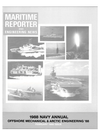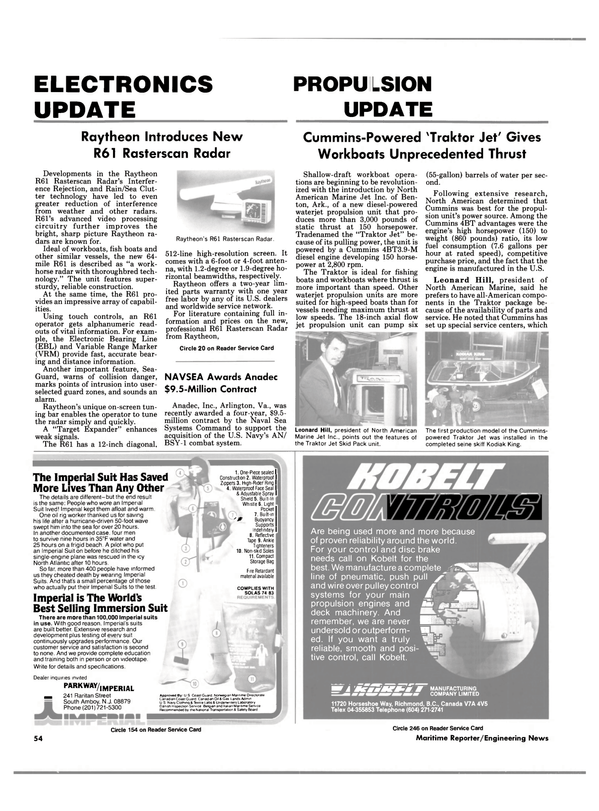
American Bureau Of Shipping— A 'Class Act' For Over 125 Years
the Atlantic Mutual Insurance Company, led a group of New York City marine insurance companies in forming a not-for-profit, benevolent purpose society to promote the safety of life at sea. This evolved into the American Bureau of Shipping which developed the procedure of rating the structural and mechanical fitness of ships called classification.
The promotion of the safety of life and property through classification has remained the central focus of ABS ever since. While this focus is unchanged, the knowledge, experience and resources of ABS have grown. In recognition of this advancement, the activities of ABS have evolved from strictly ship classification into related areas. Today, ABS and its subsidiaries of the ABS Group of Companies, Inc. provide certification, inspection, analysis, quality assurance, and ship classification service to marine, offshore, government and industrial sectors on a worldwide basis.
The first ABS rules, those for Building and Classing Wooden Vessels, were published in 1870.
Since that time, ABS rules have kept pace with the developments in the shipbuilding industry, with Rules for Building and Classing Iron Vessels published in 1877; and Rules for Building and Classing Steel Vessels in 1890. These latter standards have been updated and published annually ever since.
The first half of the 1940s was a time of unprecedented growth for ABS. From the start of World War II through 1945, a total of 5,171 Liberty Ships, Victory Ships, T-2 tankers and various other type vessels were built to ABS classification as part of the Maritime Commission's Wartime Shipbuilding Program.
This set the stage for ABS's emergence as an international organization.
Following the war, ABS representation expanded throughout the world, as the government sold hundreds of ABS class surplus vessels to allies who had lost a large portion of their fleets. Today, ABS has nearly 850 exclusive surveyors and engineers stationed in 168 locations around the world, on call 24- hours-a-day.
The late 1950s and early 1960s marked a significant transition period for ABS and for the shipbuilding industry—a technological transition.
Up until that time, the primary criterion by which a ship could be classed was by comparison with similar ships proven successful in service.
However, advancements in marine design made it evident that a means for analyzing innovative structures was needed.
ABS responded in 1965 by participating with the University of Arizona and Chevron Shipping Company in a research project to develop a finite element system of programs, known as DAISY, for a computeraided analysis of any type of vessel structure.
By the early 1970s, computeraided finite element analysis enabled ABS to class a number of innovative ship types—large selfpropelled LNG carriers, pure container and barge carriers, very large crude carriers, floating industrial units, rigidly integrated tug-barge combinations, and mobile offshore drilling units.
Also, with the innovations of the 1960s, there arose a need for classification standards for application to special purpose vessels whose unique structural or mechanical features were not comprehensively covered by the ABS rules for steel vessels.
Therefore, ABS published guides covering the construction and classification of nuclear ships, underwater systems and vehicles and mobile drilling units. As the years went on, ABS special rules and guides have been published to fit the needs of the marine and offshore industry, and in 1987, its 125th year, ABS published 21 different guides, including the Guide for Building and Classing Offshore Racing Yachts, and 16 different rules.
In 1970, ABS Worldwide Technical Services, Inc. (ABSTECH) was formed as a wholly owned subsidiary of ABS to provide certification, inspection, analysis and quality assurance services to the marine sector for functions above and beyond those traditionally performed and also to related nonclassification services in the industrial sector.
In 1978, ABS commenced classification and certification services with site specific structures of various types including single point moorings, hydrocarbon production and processing structures, floating production storage offloading units, and steel and concrete caisson drilling units and concrete islands.
As the 1970s moved on to the 1980s, ABS activity with all types of vessels continued to increase, but its work with the offshore sector grew the fastest. ABS had been involved with mobile offshore drilling units (MODUs) since their inception in the Gulf of Mexico some 25 years earlier. About two-thirds of the world's MODUs are ABS classed.
Late in 1981 and early 1982, the U.S. Coast Guard signed a two-year Memorandum of Understanding with ABS under the terms which the Coast Guard agreed to accept ABS plan review and inspection of various hull and machinery items for construction of U.S.-flag vessels built to ABS class and USCG certification requirements. As extensions of this Memorandum in early 1982 the Coast Guard also agreed to accept ABS admeasurement and tonnage certification of their behalf.
The 1980s saw the continued expansion of their services. ABS services encompassed such areas as marine hydrodynamics, seakeeping, stability, mooring analysis, finite element structural mechanics and structural dynamics, vibration and noise prediction and prevention, and fatigue analysis. In another area survey methods were developed by ABS during this time to replace traditional ones. Typical of this is the comprehensive preventive maintenance program based on condition monitoring using such techniques as vibration analysis, lubrication oil analysis, and other more sophisticated techniques to determine the operational conditions of a particular machinery item.
During the same period, ABS also developed synchronized surveys in order to help owners time various classification surveys and those required by international marine safety conventions so that they would coincide to the maximum extent possible. Other survey procedures were offered such as underwater inspection, voyage surveys, and tailshaft monitoring in lieu of withdrawal.
During this period, ABS developed its quality assurance system of programs for individual, batch, and mass produced products, as well as manufacturing processes. These services have become well accepted and by the beginning of 1986, almost 1,000 manufacturers were enrolled in the various ABS quality assurance and related programs.
In 1983, a new division of ABSTECH, called ABS Boiler Marine and Insurance Company, was formed to carry out examinations of boilers, pressure vessels and pressure- related equipment according to ASME code. Additionally, that same year a second ABSTECH division, ABS Oil Testing Services, Inc., was formed to complete tests of bunker fuels and lubricating oils used in main onboard propulsion and machinery systems and power generation and industrial plants.
To better fit everyday use of the ABS rules with computer technology, in 1985 ABS instituted the EAGLE system of computer programs.
This system is available to shipyards, designers and other outside users as well as ABS and has great potential benefit to all by affording substantial time and cost saving by accelerating the ABS plan review process in addition to eliminating duplication of effort. By the end of 1986, EAGLE contained several of the ABS rules and the aim is to include all of the computer programs for ABS rules in its vocabulary and also computer programs for a wide spectrum of related functions such as hull girder strength, ship hydrostatics, structural frame analysis and stability.
The 125th year of ABS, celebrated last year, saw the enactment of an important new business approach.
ABS intensified its activities in nonmarine and nonclassification work as well as concentrated on its basic classification business. For this purpose the ABS organization was reorganized into three groups— the American Bureau of Shipping, which will continue classification and statutory work; ABS Worldwide Technical Services, Inc.
(ABSTECH), which will continue and intensify marine and industrial advisory services; and ABS Government Services Business Unit (GSBU), which will provide nonclassification marine services to government agencies worldwide.
For free literature containing detailed information on the full range of classification and nonclassification marine services offered by the ABS and its subsidiaries, Circle 21 on Reader Service Card
Read American Bureau Of Shipping— A 'Class Act' For Over 125 Years in Pdf, Flash or Html5 edition of February 1988 Maritime Reporter
Other stories from February 1988 issue
Content
- Almerico to Manage Trinity's Mississippi Shipbuilding Operations page: 5
- New Swagelok Tube Fittings Incorporate Sanitary Flanges page: 5
- Mitsubishi's High-Speed Passenger Boat Promises New Era In Smooth Sailing page: 6
- New Emergency Marker Lights Described In Color Brochure From American Cyanamid Co. page: 6
- New Products From Furuno: Advanced FAP-50 Autopilot, And Weatherfax xWith A Twist' page: 8
- Canadian Shipbuilding And Ship Repairing Association (CSSRA) Becomes CMIA page: 9
- Cruise Ship Industry Spurs Construction in Italian Yards page: 10
- Fincantieri Converting Six Ferries Under $74.4-Million Contract page: 10
- Major U.S. Shipping Companies Form New Industry Association page: 11
- Aluminum Boats Constructing 138-Foot Detroit Diesel-Powered Luxury Dinner/Cruise Vessel page: 11
- Free N ew Color Brochure Features Dampa Products page: 11
- U.S. Opens Port Of Coos Bay To Polish Ship Repairs page: 12
- American Welding Society Announces Spring Welding Education Seminar Series page: 12
- Video Describes Port Design Process And Use Of Simulation page: 13
- Hagglunds To Acquire Dutch Crane Group page: 14
- 5 Canadian Consortiums Contend For $5-Billion Domestic Sub Project page: 15
- Ceramic Coatings Approved By ABS For Diesel Engine Use page: 15
- 7th International Symposium Offshore Mechanics And Arctic Engineering page: 16
- Marine coatings & corrosion control page: 20
- Grow Group, Inc. Announces Personnel Changes page: 24
- Converted Detroit Diesel-Powered Crewboat Includes Airliner Features For Passengers, Cargo page: 25
- Kim Hotstart Pre-Heating Systems Shrink Engine Idling Costs page: 25
- Robertson Autopilot Wins NMEA Honors page: 26
- FULL FUNDING FOR TWO NEW CARRIERS GIVES NAVY 46% INCREASE FOR SHIPBUILDING page: 29
- NAVY RESEARCH AND DEVELOPMENT page: 39
- Southern California Sections Of American Society Of Naval Engineers To Hold Centennial Symposium page: 40
- Navy Plans To Develop ASW Minisubmarine Fleet At Cost Of $5 Billion page: 40
- Navy Shiphandling Simulator Training Expanded page: 41
- $25-Million Navy Order For Caterpillar Generators Announced By H.O. Penn page: 41
- MAJOR NAVY CONTRACTS page: 42
- Navy Secretary Webb Guest Speaker At Joint Meeting Of Propeller Club-U.S.M.M.A. Alumni page: 42
- Ingalls Awarded Navy Contract Worth $378.7 Million To Build Third LHD Ship page: 44
- Bird-Johnson Promotes Ike L. Svensson To GM-Seattle Operations page: 47
- MAN GHH Merges Crane Subsidiaries page: 50
- Fjellstrand Delivers New Design, High-Speed 200-Passenger Ferry page: 51
- Si-Tex Offers Budget Radiotelephone; Reintroduces EZ-7 Loran-C Receiver page: 51
- American Bureau Of Shipping— A 'Class Act' For Over 125 Years page: 52
- Raytheon Introduces New R61 Rasterscan Radar page: 54
- Cummins-Powered 'Traktor Jet' Gives Workboats Unprecedented Thrust page: 54
- Cummins Announces Availability Of New XA' Series Diesel Engines page: 55
- Westmark Completes Acquisition Of Tracor page: 55
- Furuno Introduces New High Resolution Color Radar page: 56
- McDermott Joint Venture Awarded Contract Worth More Than $100 Million page: 56
- New Container Liner Bags Cut Liquid Carriage Costs page: 56
- Bender Posts Successful Recovery From Chapter 11 page: 57
- Spar Associates Awarded Systems Contract By Halifax-Dartmouth page: 61
- Free Brochure On Marine Technical Services Offered By Clyde Leavitt, Inc. page: 62
- EES Corporation Offers Brochure On 'Omnipure' Sewage Treatment Plants page: 62
- Wartsila Diesel Presents A New Auxiliary Engine, The Vasa 2 2 / 26 page: 69


